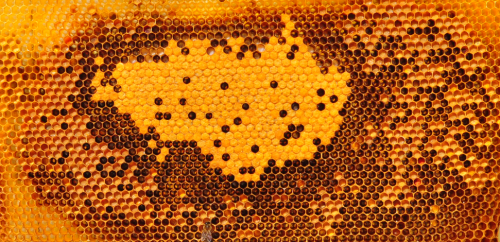
In Flemming V’s blog of last week, 35 kg pollen was mentioned as the amount a colony collects. Is this realistic, too much or too few? Rortais et al. (2005), reviewed the bee’s pollen consumption literature comprehensively and noted 10 up to 55 kg collected annually per colony. Crailsheim et al., calculated the annual pollen consumption in two colonies to be 13.4 and 17.8 kg respectively in colonies of about 25 000 bees in June-August. Wille et al., recorded 10 to 26 kg pollen per year. It obviously depends on the colony size, colony development, environment and pollen type. For example, pollen of maize is consumed in about the double amount compared to mixed pollen, due to its relative low percentage of nutrients of the whole pollen grain. The percentage protein of the dry weight is comparable to mixed pollen (Höcherl et al, 12012). Obviously, there is no fixed amount a colony could or should collect to grow, maintain and function. Nevertheless there good studies available to assess the annual pollen need for a colony. Based on the aforementioned Rortais et al. (2005) article, a nurse bee consumes on average 65 mg pollen and a worker-larvae 5.40 mg. Consequently, a bee consumes in her life minimally 70.4 mg. This is the average estimation, double amounts have been reported as well. In the aforementioned Crailsheim et al study the pollen consumption per day was 3.4 to 4.3 mg. In a 30-days life span of the summer honeybee this is approximately 115 mg in her lifespan. Another approach to assess pollen consumption is presented in the review article of Keller et al., (2005a). It is the assessment of pollen consumption based on nitrogen (N) in brood and bees. Pollen is the solely N source in the bee’s diet. To convert N to pollen, it is assumed that the pollen protein contains 16% nitrogen, that pollen contains 20% protein and that the digestive efficiency is 80%. So, for 10 mg N, it takes 62.5 mg protein; for 62.5 mg protein it takes 312.5 mg pollen and by the efficacy of the alimentary process it takes 390.6 mg pollen consumed by the bee. Taking all this into account it takes 125 mg pollen to raise a bee. The N in the bees after emergence, increases by 0.86 mg. The 0.86 mg N correspond to 39 mg pollen. So in total each bees required minimally 125 + 39 = 164 mg pollen as N loss by defecation is not taken into account. Counting the bee’s active and reproducing period on 200 days and the average life span of a bee of 35 days (Steen et al, 2012), it takes 200/35 = 6 generations. To maintain a colony of on average 15000 bees, 15000 x 6 = 90000 bees are raised. The number of bees raised annually and the calculated amount of pollen required are summarised in table 1.

The 35 kg mentioned in the beginning is the amount required for a big colony and is an optimal estimation. Amounts varying between 15 and 25 looks more realistic. Again, it all depends on pollen type, environment, colony development and yes/no pollen trap. Depriving colonies from pollen stimulated pollen collection. It is up to the beekeeper to maintain an adequate pollen flow. To check whether the pollen stores are sufficient it simply takes a rough estimation of the surface/ number of beebread cells in a colony. A healthy normally sized colony needs / consumes per day about 0.5 to 2 dm2 (200 – 800 half-full beebread cells). Another simple estimation is weighing the harvest of the pollen trap. It must be taken into account that the efficacy of the pollen trap varies between 10 and 50% (Keller et al., 2005b).
References
Crailsheim, K., Schneider, L. H. W., Hrassnigg, N., Bühlmann, G., Brosch, U., Gmeinbauer, R., & Schöffmann, B. (1992). Pollen consumption and utilization in worker honeybees (Apis mellifera carnica): dependence on individual age and function. Journal of insect Physiology, 38(6), 409-419.
Höcherl, N., Siede, R., Illies, I., Gätschenberger, H., & Tautz, J. (2012). Evaluation of the nutritive value of maize for honey bees. Journal of insect physiology, 58(2), 278-285.
Keller, I., Fluri, P., & Imdorf, A. (2005a). Pollen nutrition and colony development in honey bees: part 1. Bee world, 86(1), 3-10.
Keller, I., Fluri, P., & Imdorf, A. (2005b). Pollen nutrition and colony development in honey bees—Part II. Bee World, 86(2), 27-34.
Rortais, A., Arnold, G., Halm, M. P., & Touffet-Briens, F. (2005). Modes of honeybees exposure to systemic insecticides: estimated amounts of contaminated pollen and nectar consumed by different categories of bees. Apidologie, 36(1), 71-83.
Steen, van der, J. J.M., Cornelissen, B., Donders, J., Blacquière, T., & van Dooremalen, C. (2012). How honey bees of successive age classes are distributed over a one storey, ten frames hive. Journal of Apicultural Research, 51(2), 174-178.
Wille, H., Wille, M., Kilchenmann, V., Imdorf, A. & Bühlmann, G. (1982). Pollenernte und Massenwechsel von drei Apis mellifera-Völkern auf demselben Bienenstand in zwei aufeinanderfolgenden Jahren. Revue Suisse de Zoologie(4), 897-914
Sjef van der Steen
